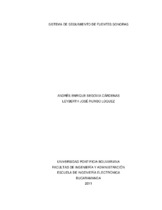| dc.contributor.advisor | Restrepo Agudelo, Raúl | |
| dc.contributor.author | Segovia Cárdenas, Andres Enrique | |
| dc.contributor.author | Rumbo Lúquez, Leyberth José | |
| dc.coverage.spatial | Seccional Bucaramanga. Universidad Pontificia Bolivariana. Escuela de Ingenierías. Facultad de Ingeniería Electrónica | spa |
| dc.coverage.temporal | 2011 | |
| dc.date.accessioned | 2013-11-05T19:23:05Z | |
| dc.date.available | 2013-11-05T19:23:05Z | |
| dc.date.created | 2011-05-27 | |
| dc.date.issued | 2013-11-05 | |
| dc.identifier.uri | http://hdl.handle.net/20.500.11912/1221 | |
| dc.description | 121p.: (pdf); il; gráficas; tablas; anexos | spa |
| dc.description.abstract | Este documento presenta el diseño de un sistema que permite seguir y ubicar de forma automática una fuente sonora. Para este fin se desarrollo un sistema que controla la orientación de un micrófono móvil, el cual permite la localización de la fuente sonora. Este proceso se hizo mediante la triangulación de las ondas sonoras de entrada en cuatro micrófonos ubicados estratégicamente en un recinto específico. La señal de control se obtuvo mediante la implementación de un algoritmo en un microcontrolador además éste último ejerce la acción de control sobre el elemento de posicionamiento. Para llevar a cabo este proyecto inicialmente se hicieron pruebas de los micrófonos electret que se usarían como sensores de posición de la fuente sonora, estos micrófonos al ser omnidireccionales, recibían seña de audio de todas las direcciones y hubo que plantear una solución para hacerlos mas directivos, esta solución fue diseñar un micrófono diferencial utilizando dos micrófonos electret uno frente al otro de tal forma que la señal de información fue la del locutor y la señal de ruido fue el sonido externo o del publico que se presentara en el recinto. Al observar la señal recibida por estos micrófonos se determino que necesitaban un acople mecánico para incrementar la señal de audio que captaban cada uno de los micrófonos electret para de esta forma ubicar la posición de locutor adecuadamente y enviar estas señales a un microcontrolador para cuantificarlas para posteriormente controlar el servomotor que mueve el micrófono diferencial que finalmente apunta hacia la ubicación del locutor. | spa |
| dc.description.abstract | This paper presents the design of a system to track and automatically locate a sound source. To this end we developed a system that controls the orientation of a mobile microphone, which allows the location of the sound source. This process was made by triangulation of the sound waves into four microphones strategically placed in a specific precinct.
The control signal is obtained by implementing an algorithm in a microcontroller this one also controls the action on the positioning element. To carry out this project initially the electret microphones were tested because they would be used as sensors for position of the sound source, as these microphones are omnidirectional, they receive audio signal from all directions and we had to pose a solution to make them more selective . This solution was to design a differential microphone using two electret microphones facing each other so that the information signal was the speaker and the noise signal was the external sound or the public to report to the campus.
By observing the signal received by these microphones was determined that they needed a mechanical coupling to increase the audio signal captured each of the electret microphone in this way locate the position of Speaker properly and send the signals to a microcontroller to quantify and subsequently control the actuator that moves the differential microphone finally points to the location of the speaker. | |
| dc.language.iso | es | |
| dc.publisher | Universidad Pontificia Bolivariana | spa |
| dc.rights | Attribution-NonCommercial-NoDerivatives 4.0 International | * |
| dc.rights.uri | http://creativecommons.org/licenses/by-nc-nd/4.0/ | * |
| dc.subject | Tesis y disertaciones académicas | spa |
| dc.subject | Reguladores eléctricos | spa |
| dc.subject | Ondas sonoras | spa |
| dc.subject | Micrófonos | spa |
| dc.subject | Detectores | spa |
| dc.title | Sistema de seguimiento de fuentes sonoras | spa |
| dc.type | bacherlorThesis | spa |
| dc.rights.accessRights | openAccess | spa |
| dc.type.hasVersion | publishedVersion | spa |
| dc.identifier.instname | instname:Universidad Pontificia Bolivariana | spa |
| dc.identifier.reponame | reponame:Repositorio Institucional de la Universidad Pontificia Bolivariana | spa |
| dc.identifier.repourl | repourl:https://repository.unab.edu.co/ | |


